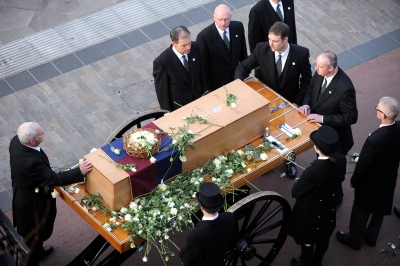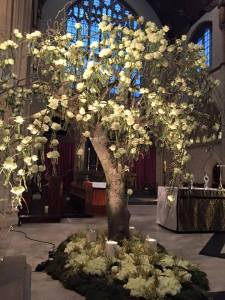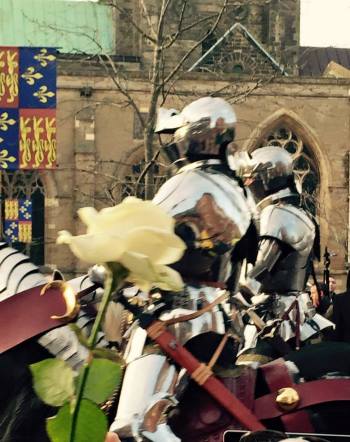 Death was ever present in medieval times (as to some extent latter centuries), and when we think about it, we may think that there was no such things as hospitals. And there wasn´t, not as we know them today. But there was places for sick people, one of them was St Mary Spital
Death was ever present in medieval times (as to some extent latter centuries), and when we think about it, we may think that there was no such things as hospitals. And there wasn´t, not as we know them today. But there was places for sick people, one of them was St Mary Spital
In 1197, just outside Bishopsgate, a priory was formed by Walter Brunus and his wife Roisia. Its name was “The new hospital of St Mary without Bishopsgate”, but it came to be known as St Mary Spital. This came to be one of the biggest hospitals in medieval England and included a large cemetery with a stone charnel house and mortuary chapel, of which the latter was discovered by archaeologists. It was one of 200 hospitals founded in England during the 12th century, and it came to be one of the biggest hospitals in medieval times providing shelter for the sick, the poor, elderly and homeless.
The original name was Hospital (or priory) of the Blessed Virgin Mary without Bishopsgate and it was located on the east side of Bishopsgate Street. The means to found it came from an undated grant of lands in Bishopsgate Street to Walter Brunus and his wife, some of them by the Alderman Walter, son of Eilred, for the purpose of the foundation.
The parcels of lands given by Walter son of Eilred consisted of 44 ells* (from the Latin ulna) towards the king´s highway (Bishopsgate Street) and 117 ells on the east side towards Lolesworth field, 162 ells in depth west to east and on the opposite side of Bishops Street 13 ells towards the street as well as 16 ells on the west side as well as a depth of 78 ells. To this should be added additional 101 ells towards Bishopsgate Street and 149 ells towards Lolesworth field from contributors whose names have been lost to history.
The church was expanded in 1235, something which was confirmed by Walter and Roisia, who finally was said to have been buried before the altar of the church.
It was the Augustinian order which ran the house, and it contained both canons regular as well as lay brothers and  sisters. One of the chief purposes of the house – and now we´re getting closer to my original intention with this subject – was to function as a lying-in hospital. An order from the 7th of January 1341 declare that the hospital was founded to receive and entertain pilgrims and the infirm who resorted thither until they were healed, and pregnant women until their delivery, and also to maintain the children of women who died there in childbirth, until the age of seven.
sisters. One of the chief purposes of the house – and now we´re getting closer to my original intention with this subject – was to function as a lying-in hospital. An order from the 7th of January 1341 declare that the hospital was founded to receive and entertain pilgrims and the infirm who resorted thither until they were healed, and pregnant women until their delivery, and also to maintain the children of women who died there in childbirth, until the age of seven.
On the 8th of August 1279 the bishop of St Paul´s confirmed a grant to the hospital of a fountain called the tongue wriggling “Snekockeswelle” in his field of Lolesworth, including the right to enclose it with a wall and through a kind of waterconduit bring it to the sick and poor within the infirmary. Just over 20 years later, in 1303, the Archbishop of Canterbury – Robert Winchelsey – ordered that the lamps which had earlier hung between the sick people for their comfort should be returned (no information as to where they had gone in the meantime)
A number of royal servants were lodged at St Mary Spital at the beginning of the 14th century, such as a servant of Edward I´s confessor and three yeomen of Edward III. It also paid off to give alms to the monastery and hospital, in 1391 a papal relaxation in penance was issued for those who did just that, with the reference to the “very many poor widows, wards and orphans are continually sustained” within.
 In a list of London parish churches and monasteries from around the mid-fifteenth century St Mary Spital is mentioned with the words “Seynt Marye Spetylle. A poore pryery, and a parysche chyrche in the same. And that pryory kepythe ospytalyte for pore men. And sum susters yn the same place to kepe the beddys for pore men that come to that place”
In a list of London parish churches and monasteries from around the mid-fifteenth century St Mary Spital is mentioned with the words “Seynt Marye Spetylle. A poore pryery, and a parysche chyrche in the same. And that pryory kepythe ospytalyte for pore men. And sum susters yn the same place to kepe the beddys for pore men that come to that place”
St Mary Spital lived on through the centuries, but when the dissolution hit, the priory itself feel. It seems however as if the hospital survived, not least since the Lord Mayor, Sir Richard Gresham, petitioned the king in 1538 that the London hospitals “Seynt Maryes Spytell, Seynt Bartholemews Spytell and Seint Thomas Spytell’ and ’the new abby of Tower hyll” should be governed by the Lord Mayor and the Aldermen.
In excavations of the area between 1991 and 2007, more than 10 000 human remains have been found, providing a unique insight to the lives in medieval London from the late 12th century to the early 16th century. Among many things one have been able to identify some of the earliest European victims of syphilis.
*An ell equated the linear measure of 45 inches. It seems the word ell has been taken to represent either the distance from the elbow or from the shoulder to the wrist or to the finger tips. It also seem that in some cases the measure “double ell” has taken over the original measure, and has taken its name. What an ell actually was differed from country to country. While an “ell” in England was, as mentioned, 45 inches, it was 37.2 inches in Scotland and 27 inches in Flanders. No accuracy is like the accuracy of medieval times! 😉
The word “ell” originate from the Latin “Ulna” which mean the bone of the forearm, opposite the thumb. Swedish potential readers – as I am Swedish – will recognise the old Swedish measurement “aln”.
Sources: http://www.british-history.ac.uk/survey-london/vol27/pp21-23
Measurement in the Middle Ages – http://www.personal.utulsa.edu/~marc-carlson/history/measure.html
Centre for human bioarchaeology – British museum
http://archive.museumoflondon.org.uk/Centre-for-Human-Bioarchaeology/Database/Medieval+cemeteries/stmaryspital.htm























